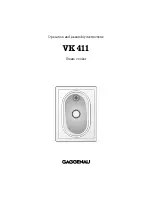
Page 43
B-210 / B-200 Curtis System Operator Manual
MB-210-14
Charging with the Signet Model
HBS Charger
Note: O p p o r t u n i t y c h a r g i n g i s n o t
recommended. For maximum battery
life, it is recommended that the batteries
be discharged a minimum of 30%
(7 bars showing on the BSI) before
starting a charging cycle.
This charger requires a standard household
electrical circuit rated at minimum of 15 Amps.
Consult an authorized electrician if you do not
know the configuration of your circuits.
1. Park the vehicle at an authorized
charging station. Refer to Parking in the
Driving section.
2. Connect the charging cord to the AC
power receptacle.
3.
The charger status LED’s will flash in
sequence as the charger performs a self
diagnosis and systems check.
4. The charger will start the charging cycle
only after it has determined that all
systems are OK.
Note: It is recommended that the charging
cycle be allowed to complete normally
before disconnect the AC power cord.
A beeping noise from the charger is an
indication of a fault during the charging cycle.
Refer below for fault information.
There is a status light panel on the charger
faceplate that displays the current status of
the charger. The first light on the left (POWER)
should be ON when the AC cord is connected
to a working AC power source.
The three STATUS LED lights will indicate the
current charging condition as follows:
•
Left
: Charge cycle is ON and is in
constant current mode.
•
Left & Middle
(80%): Charge cycle is
ON and is in constant voltage mode.
•
Right
(100%): Charge cycle completed.
The FAULT light will turn ON and flash a fault
code only if an abnormal charging condition
has occurred. Refer to the following fault code
table for more information.
Note: Critical faults will be accompanied with
an audible beeping.
Refer to grouped safety warnings and
information at the start of this chapter.
WARNING
Fault
Code
Description
Action Required
1
(no flash)
Time out
The charging cycle did not complete when expected. This could
be due to too deep of a discharge or faulty batteries. If the fault
reoccurs, have the batteries tested by a qualified technician.
2*
Open circuit or reverse
polarity to the battery
Check the charger connections to the battery.
3*
Battery voltage too high Wrong charger installed. Confirm that the charger voltage
matches the battery voltage.
4
Charger overheated
Check for dirt, mud, or other debris on the charger cooling fins
and clean as needed.
5*
AC line voltage out of
range
**Check the input AC line voltage.
The voltage must be within 85-135 VAC or 170-264 VAC
6
Low battery voltage
Battery discharged too deep, faulty battery, or incorrectly wired
battery.
The charger will operate in low current mode until the battery
voltage is up to a normal level then resume normal charging.
If this fault does not reset, have the battery tested by a qualified
technician and check the battery wiring.
*
These faults will be accompanied with an audible beep and indicates that the charging cycle
was terminated prematurely.
**
Only a qualified electrician should check the AC line voltage
















































